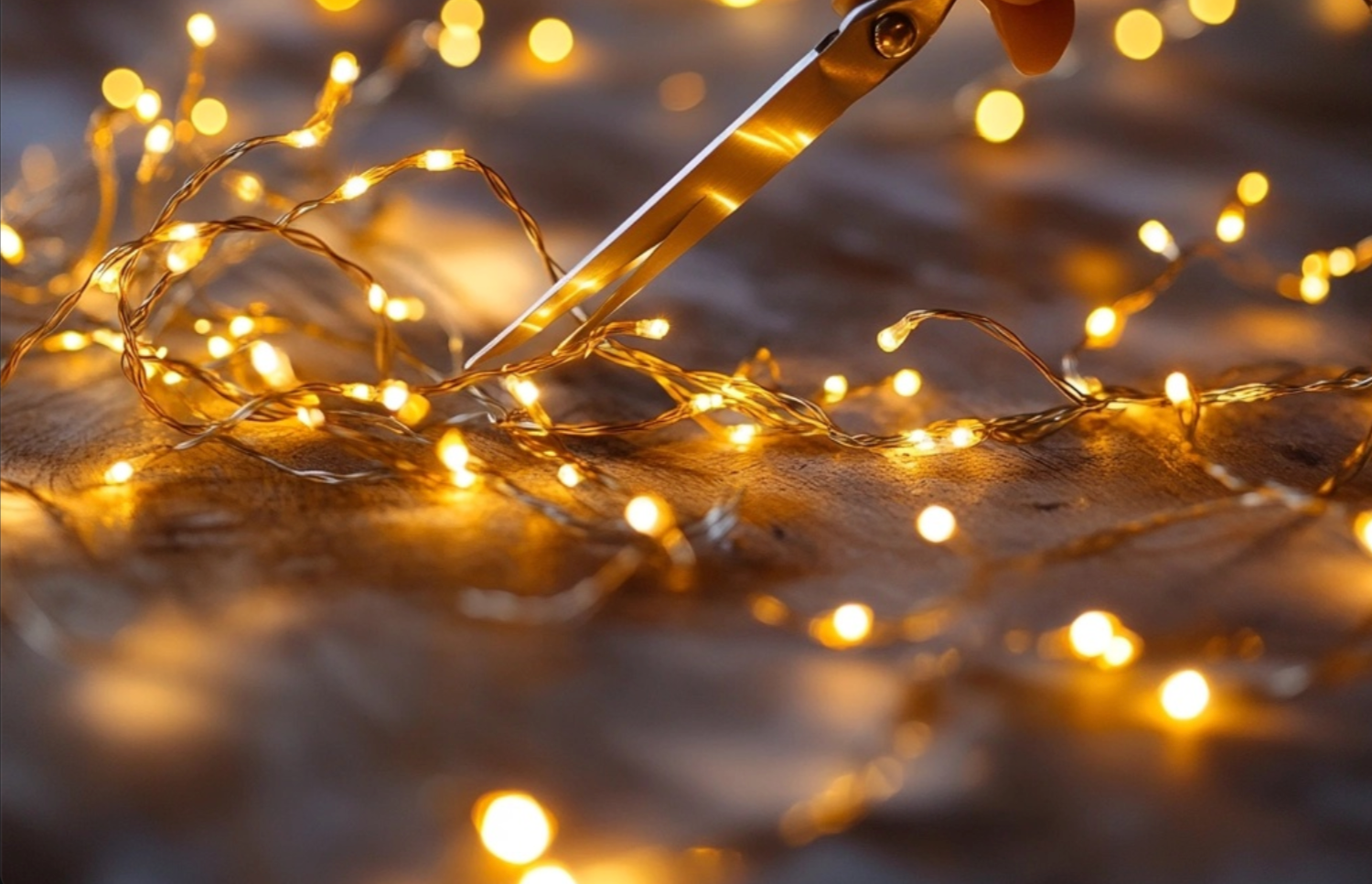As the holiday season approaches or when decorating spaces year-round, many people wonder if they can customize their fairy light strands to fit specific spaces or create unique lighting designs. But before taking scissors to your twinkly decorations, you need to know: can you cut fairy lights?
No, fairy lights should not be cut. Cutting through the wiring of fairy lights can create electrical hazards, damage the entire string of lights, and void any warranty or safety certifications the product may have.
While this answer might be disappointing if you're trying to customize your lighting setup, don't stop reading just yet. There are several safe and effective alternatives to cutting fairy lights that will help you achieve the perfect lighting arrangement you're looking for, and we'll explore these solutions in detail below.
Safe Alternatives To Cutting Fairy Lights
Instead of cutting fairy lights, consider using cable ties or clear command hooks to manage excess wire length. These tools allow you to bundle and secure extra wire neatly without compromising the electrical integrity of the lights. For an even more polished look, clear cord clips can be used to guide the wire along specific paths while hiding excess length.
Another excellent solution is to purchase shorter strands of fairy lights or ones specifically designed with connecting functionality. Many manufacturers now offer modular fairy light sets that can be linked together to achieve your desired length, eliminating the need for cutting.
How To Choose The Right Length Of Fairy Lights
Before purchasing fairy lights, measure the area where you plan to install them. A good rule of thumb is to add an extra 10% to your measured length to account for any slack needed around corners or obstacles. For trees or vertical installations, multiply the height by 3 to ensure adequate coverage.
Consider also whether you'll need to reach a power outlet. If the distance to the nearest outlet is significant, you may want to factor this into your total length calculation or plan to use an extension cord rated for outdoor use if necessary.
Top-Rated Fairy Lights Worth Checking Out
Explore an assortment of high-quality, top-rated fairy lights.
Minetom Star String Lights

Twinkle Star 300 LED Curtain String Lights

HXWEIYE 300LED Fairy Curtain Lights

What To Do If Your Fairy Lights Are Too Long
If you find yourself with fairy lights that are longer than needed, there are several creative solutions. You can create decorative loops or swags with the excess length, adding visual interest to your display. Another option is to double back the strand, creating a denser light pattern that can enhance the overall effect.
For permanent installations, consider winding the excess cord around a decorative element like a banister or beam. This not only manages the extra length but can also create an attractive focal point in your space. Just be sure not to bend the wires at sharp angles or create tight knots that could damage the wiring.
When To Replace Fairy Lights Instead Of Trying To Modify Them
If you're considering cutting fairy lights because they're not functioning properly or no longer meet your needs, it might be time for a replacement. Modern LED fairy lights are not only more energy-efficient but also come in a wider variety of lengths, colors, and control options than older models. They typically last 25,000-50,000 hours, making them a worthwhile investment.
Additionally, newer fairy lights often feature remote controls, timer functions, and even smart home compatibility, allowing for more customization without physical modifications. If your current lights are more than a few years old, upgrading to a new set might be more cost-effective and safer than attempting modifications.
How To Safely Store Fairy Lights To Prevent Future Length Issues
Proper storage of fairy lights can prevent tangling and damage that might tempt you to cut them in frustration. Start by wrapping the lights around a piece of cardboard or a storage reel, being careful not to create any sharp bends in the wire. Secure the wrapped lights with twist ties or velcro straps, but avoid using rubber bands which can damage the wiring over time.
Store the wrapped lights in a dry, temperature-controlled environment, away from direct sunlight and extreme temperatures. Consider labeling each strand with its length and any specific usage notes to make future decorating easier. This organized approach to storage will help ensure your lights remain in good condition and are ready to use at their full length when needed.
Taking The Next Step With Your Holiday Lighting
Before starting your next decorating project, take a few minutes to measure your space and create a lighting plan that accounts for the exact lengths you'll need. This simple step will help you purchase the right size fairy lights from the start, eliminating any temptation to modify them unsafely and ensuring a beautiful, professional-looking display that you can enjoy for years to come.
Electrical Safety Considerations
Voltage and Wattage Basics
Fairy lights typically operate at low voltage—especially modern LED sets—but that doesn’t mean they are risk-free. The voltage determines how much power is running through the wires, and the wattage indicates total energy consumption. When you cut or modify fairy lights, you disrupt the designed electrical circuit. This can create uneven electrical flow, potentially leading to short circuits or damage to internal components. Always follow manufacturer instructions and avoid tampering with the wiring to maintain a safe, stable electrical current.
UL/CE/ETL Certifications
Certifications such as UL (Underwriters Laboratories), CE (Conformité Européenne), or ETL (Intertek) indicate that a product has been tested and meets specific safety standards. Modifying fairy lights—like cutting the strands—usually voids these certifications. Once you alter the product, you’re no longer using it as it was tested and approved, which can negate any protection a warranty might offer and introduce possible hazards.
Common Hazards of Modifying Wires
When you cut or splice fairy light wires, you risk exposing bare conductors. This can lead to:
-
Fire Hazards: Damaged wiring can overheat or spark, particularly in environments with flammable materials.
-
Short Circuits: Cutting or incorrectly reconnecting wires can create a direct short, potentially leading to blown fuses or tripped breakers.
-
Electrocution: While low-voltage fairy lights pose less risk than high-voltage systems, there is still a potential shock hazard if exposed wires contact skin or conductive materials.
Warranties and Manufacturer Guidelines
What the Warranty Covers
Most fairy light warranties cover defects in materials or workmanship under normal use. If you cut or otherwise modify the light strand, the manufacturer will almost always void that warranty. This means any future issues—whether they stem from your modifications or not—will likely not be covered. Typical warranties might also exclude damage due to improper storage or exposure to extreme weather if the lights aren’t rated for outdoor use.
Manufacturer-Specific Instructions
Some brands provide detailed guidelines on what can and can’t be done with their lights. For example, certain products are designed with replaceable bulbs or detachable sections. However, even if a set has detachable sections, it often doesn’t permit cutting the wiring itself. Always consult the owner’s manual or the manufacturer’s website. Even minor alterations not outlined by the company can void safety certifications and warranties, leaving you without recourse if something goes wrong.
Creative DIY Tips (Without Cutting)
Using Fairy Light Extensions
If you find your lights are too short, look for extension accessories or connector sets designed for your specific brand or model. Some fairy lights are built with end-to-end connectors that let you chain multiple strands together. This allows you to achieve extra length without breaking the circuit or risking damage. Always ensure any extensions or connectors match the voltage and style of your existing lights to maintain safety.
Battery Packs for Custom Placement
Opt for battery-powered fairy lights if you want more freedom in placement. Without needing a nearby outlet, battery packs let you decorate centerpieces, wreaths, or outdoor areas more easily. They also remove the temptation to cut or splice wires to achieve a certain layout. Just be sure to switch off or remove batteries when not in use to extend battery life and maintain safety.
DIY Shapes & Forms
Instead of altering the strands, use them creatively:
-
Wire Frames or Wreaths: Wrap lights around pre-formed metal frames to create shapes like stars, hearts, or letters.
-
Hanging Displays: Drape multiple strands at different lengths from the ceiling or along a wall for a whimsical look.
-
Lanterns or Mason Jars: Place fairy lights inside to create soft, ambient lighting without any need for cutting.
Why It’s Helpful
Providing alternatives to cutting shows readers that they can still achieve a custom look without compromising safety or voiding their warranty. These ideas spark creativity, proving there’s no need to tamper with the wiring.
Troubleshooting Common Problems
Burnt-Out Bulbs or Sections Not Lighting Up
Some strands (especially older or incandescent ones) allow for individual bulb replacement. If a single bulb is out, it can sometimes affect the entire section. Check the user manual to see if bulbs are replaceable or if the fuse is accessible near the plug. For LED strands with sealed bulbs, replacement might not be possible—if a bulb goes out, you may need to replace the entire strand.
Twisted or Knotted Wires
Untangling fairy lights can be frustrating, but resist the urge to snip! Instead, gently work through knots by loosening them with your fingers or using a small, dull tool (like a pencil eraser). Store the lights properly (wrapped around a reel or piece of cardboard) to prevent future tangles and reduce stress on the wiring.
Overheating Concerns
While LED fairy lights stay cooler than incandescent varieties, overheating can still occur if the lights are used in a confined space or are bunched tightly without ventilation. If you notice the lights or plug becoming excessively warm, unplug them and let everything cool down. Consistent overheating is a sign that the lights may be faulty or not suited for your application.
Energy Efficiency and Cost Considerations
LED vs. Incandescent Power Usage
LED fairy lights consume significantly less power and produce minimal heat compared to their incandescent counterparts. While they might be slightly pricier upfront, LEDs often pay for themselves in energy savings over time. They’re also more durable and less prone to burning out, making them a better long-term investment.
Timers and Automation
Using a timer or a smart plug can help you automatically turn your fairy lights on and off, reducing electricity usage and extending the life of the lights. Remote controls and smart home integrations (like Alexa or Google Assistant) can also add convenience, especially for hard-to-reach outlets.
Long-Term Cost Savings
Opting for the correct set from the beginning is usually more cost-effective than trying to modify or replace strands repeatedly. While LED sets might cost more initially, their lower power usage and longer lifespan (often 25,000+ hours) can save you money in the long run. Plus, you avoid safety risks associated with cutting or altering the wiring.
Eco-Friendly Disposal and Recycling
Disposing of Broken Fairy Lights
If your fairy lights are irreparably damaged, don’t just toss them in the trash. Some components, such as glass or copper wiring, may be recyclable. Check local e-waste facilities or recycling centers that accept electronics or string lights. Proper disposal helps prevent harmful materials from ending up in landfills and reduces environmental impact.
Upcycling Ideas
If only part of your strand is broken, or you have older fairy lights that no longer shine like they used to, consider:
-
Craft Projects: Use the wire for decorations or art pieces.
-
Outdoor Ambient Lighting: Place working sections in clear containers or lanterns to create soft lighting for a patio or garden.
-
Holiday Décor: Repurpose them in wreaths, centerpieces, or tabletop displays, even if the lights aren’t fully functional.


